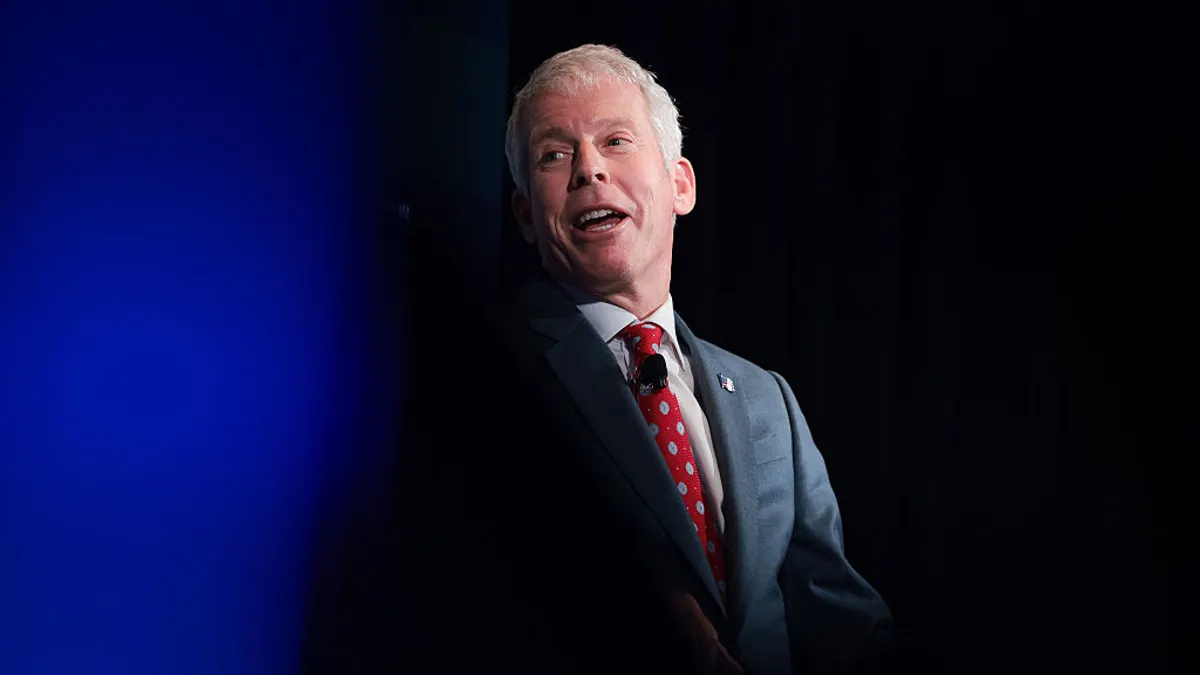A California utility is facing a major test with distributed energy resource aggregation.
Using smart inverters, residential battery storage and General Electric’s Distributed Resource Management System (DERMS), Pacific Gas & Electric is setting out with a pilot project to see how these technologies can strengthen the system while demonstrating their operations.
The ultimate goal is to see how distributed energy resource (DER) hardware and utility and aggregator operating platforms work together. If successful, the pilot project could set the stage to bring DER aggregations into utility operations.
“There have been other DERMS pilots but this seems to be more comprehensive, especially when you are coordinating with a provider of smart inverters and another provider of residential battery storage,” Omar Saadeh, senior grid research analyst for GTM Research, told Utility Dive. “It seems like a step beyond the DERMS pilots we have seen.”
Mark Esguerra, principle of distribution planning at PG&E, said this demonstration is in anticipation of growing DER adoption among customers. Right now, PG&E has more than 250,000 customers using 1,700 MW of rooftop solar, as well as 65,000 electric vehicles (EVs) charging on its system.
But it’s not just for PG&E’s benefit. The demonstration project is pulling in some big names, with those companies setting their own goals for performance testing. For example, SolarCity, which will provide the residential battery system and software, wants to showcase how it can perform on a technical scale, and how its software program can mediate between the storage and the utility.
“This pilot will be an example of distributed resources’ ability to provide services to the grid and the grid operator,” Ryan Hanley, SolarCity’s senior vice president for grid engineering said. “It is an important step toward unlocking the value for the customer and for the grid.”
For Enphase, it's a chance to break ground by testing smart inverters at customer-sited solar installations.
“We will be able to demonstrate the capability of our grid optimization aggregation service to get production data on distributed resources from the field to PG&E and relay control of them down from PG&E,” said Joe Matamoros, Enphase's head of utility services. “Putting DER and smart inverters at customer sites and coordinating with the utility’s equipment is breaking new ground.”
In PG&E's case, the pilot is expected to help “answer critical technology questions and plan investments to support the future high-DER penetration grid,” Esguerra said.
Using GE's DERMS platform could help PG&E in “enabling the initial participation of aggregated DERs in CAISO markets,” he added.
The mechanics of the pilot
Three demonstration projects will be located and coordinated on two PG&E feeders in San Jose, Esguerra said. The first two will use smart inverters and behind-the-meter energy storage, demonstrating the utility’s ability to dispatch DER through the aggregators.
The third project will test the capability of GE’s DERMS platform to work through the SolarCity’s software and Enphase’s grid optimization aggregation service, he added. PG&E will then be able to evaluate how effectively customer-sited solar, paired with energy storage and smart inverters “can be controlled and coordinated through grid management technology,” Esguerra said.
“The goal is to know the extent to which “the DERMS technology enhances the stability and power quality of the grid and optimizes solar generation and power-flow management,” he added.
PG&E’s system will have to connect to two different aggregators’ platforms, but regulatory orders require California’s aggregated DER trials to move beyond the demonstration phase in 2018, said Matamoros. “There will be many other aggregators, many with their own platforms. PG&E wants to be certain this DERMS platform offers a standard way to connect to them.”
GTM’s Saadeh said the San Jose will demonstrate PG&E’s ability to use customer-sited DER to shift the system’s load aimed at managing peak demand, and use DERs as a non-wire alternative to substation upgrades.
The pilot project is slated to begin in September and will end at the end of 2017, and includes up to 150 residential customers and 10 commercial customers.
PG&E will interface 0.5 MW of SolarCity-controlled solar plus residential storage systems using ABB smart inverters and 0.5 MW of solar working through Enphase smart inverters.
SolarCity and Enphase were selected “based on the current penetration of existing solar in the feeders," Esguerra said. For the batteries inside the SolarCity residential systems, PG&E is still selecting vendors through a competitive solicitation.
The Electric Program Investment Charge (EPIC), created by the CPUC in 2011 to support clean energy development, is funding the program. PG&E has contracted with both SolarCity and Enphase to cover the cost of deploying the assets. Both will use their resources in customer acquisition, hardware deployment, and the application of their software technologies, Hanley and Matamoros reported.
“Though the utility retains control of the battery during the pilot, the customer gets the battery for free and can use it for backup power, Hanley said. When the pilot finishes at the end of 2017, the customer will retain full use of the battery and can use it "in conjunction with SolarCity for other potentially revenue-producing benefits."
Big picture project
The San Jose pilot is about the big picture of demonstrating how effectively the utility’s GE DERMS platform can “monitor, optimize, and dispatch DERs” in demonstrations of “up to six use cases,” Esguerra said.
One is handling “load masking” or “phantom load,” demonstrating the DERMS platform’s ability to gather data from the provider's platforms on DER production, while allowing the utility to see it in real time.
“PG&E’s smart meters don’t distinguish how solar is affecting load so it can’t prepare to deal with a change in load if solar goes away suddenly or over time,” Matamoros said. With data from smart meters, the GE DERMS can allow the utility’s system “to prepare for changes in net load associated with solar, either from a momentary change in the cloud cover or from a shift in demand.”
Similarly, the DERMS platform could manage equipment capacity constraints to “dynamically mitigate overload issues,” Esguerra said. One example would be the platform drawing on DER flexibility to increase load by charging storage or reduce generation by curtailing the output.
It could also make changes in storage charging or output from DERs to mitigate voltage issues with real power output that increases or decreases system voltage; or the pilot could use smart inverters’ reactive power to mitigate such voltage issues.`
The DERMS platform could demonstrate its capability to load shift for system balancing or to arbitrage between peak demand and off-peak demand “based on economic factors such as cost or external pricing signals,” according to Esguerra
Finally, it could demonstrate increased operational flexibility based on “forecasts and optimizations during abnormal switching configurations,” Esguerra said.
The future of DERMs
“Over the past five years, DERMS has increasingly been deployed by utilities to accommodate the high penetration of DER on specific feeders and to help leverage behind-the-meter assets for utility services or grid needs,” Saadeh said, using deployments by Con Ed and San Diego Gas & Electric as examples.
But those utility deployments were for direct utility control of the customer-sited DER. Conversely, the PG&E pilot is “a more advanced and progressive use” because it tests the DERMS platform’s capability to work through multiple stakeholders’ systems, Saadeh added.
“A major factor in PG&E’s selection of this GE/Alstom DERMS platform is its emphasis on use at the enterprise level rather than at a substation or as pole-mounted distributed intelligence,” he said. Markets with higher adoption of DERs will likely see an accelerated use of DERMs, Saadeh said. One example is Hawaii, where the state’s 100% renewables-by-2045 has already driven dramatically high penetrations of rooftop solar.
California’s market is likely to accelerate after 2018, when policies open up opportunities to begin engaging at scale and recruiting customer-sited resources for the marketplace, Saadeh added.
SolarCity is also part of DER aggregation pilots in Connecticut, Hawaii as well as Southern California Edison in the Los Angeles region.
“DER are ready today,” Hanley said. “The PG&E pilot is a big step forward but it doesn’t mean DER have to wait until it is complete to be deemed ready to go. They are ready to be used to help with the situation created by [Los Angeles'] Aliso Canyon leak or anywhere else.”
Enphase has demonstrated in in other utility pilots that smart inverters can provide voltage management and DER management, Matamoros said. “But this pilot will demonstrate the utility can connect to third party aggregators’ systems instead of building out an entirely new network and communications platform."






















